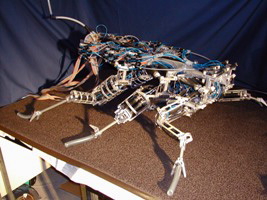The
off-road robo-roach
Page 4
 In
the past, Roger Quinn and his robotics team at Case Western Reserve
University have also worked with stylized cockroach robots like
the Stanford and Michigan machines. For their newest project,
however, they decided to take a new tack and mimic a cockroach’s
structure as closely as possible. In
the past, Roger Quinn and his robotics team at Case Western Reserve
University have also worked with stylized cockroach robots like
the Stanford and Michigan machines. For their newest project,
however, they decided to take a new tack and mimic a cockroach’s
structure as closely as possible.
Their robot, like the real
thing, has jointed legs that are small and nimble in the front
and long and powerful in the back. The legs, though 20 times bigger
than a live roach’s and attached to a simple metal rod rather
than a cockroach-like body, look disturbingly realistic and ready
to run. Their appearance is misleading, however. The robot can’t
move. The jointed legs are so complicated that the engineers are
still designing their controls. But Quinn says that once the robot
is mobile its joints will allow it to do things that simpler robots
can’t, like stepping sideways to avoid an obstacle or change
where it places its feet to stepping across a hole or over a slatted
surface.
Though the robot can’t
walk, it is mechanically stable. It can step in place in the tripod
gate, and, if pushed, bounces back into place. The artificial
air-controlled muscles that power the robot act as shock absorbers
at every joint in the leg. The muscles consist of rubber tubing
inside a woven metal tube that works like a stretched Chinese
finger trap. When the rubber tube is filled with air, the metal
tube widens and consequently shortens. By filling both halves
of an opposing pair with a little air, each joint of the leg becomes
a tuned spring working to balance the robot.
With
these three robots, engineers have demonstrated that a legged
robot can run stably—even over bumpy terrain—using
basic, mechanical cockroach motion. But a robot that can run over
rough ground in a blind, unending straight line is still not very
useful (except, perhaps, in the minefield scenario). The next
step for engineers is to give their robots sense organs like antennae,
eyes, ears, and noses so they can avoid obstacles, and, most importantly,
a brain that will allow them to complete their missions without
a human at the helm.
Though
the obstacles engineers face are formidable, Quinn projects that
a fully autonomous off-road robot will be developed in the next
five years.Five years beyond that, robotic cockroaches may be
finding survivors in disaster wreckage, exploring the surfaces
of distant planets,...
|